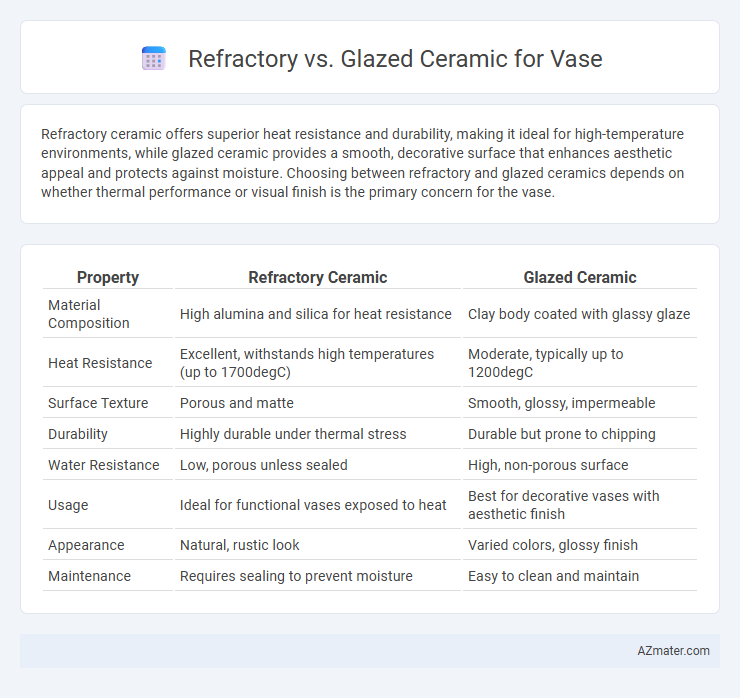Refractory ceramic offers superior heat resistance and durability, making it ideal for high-temperature environments, while glazed ceramic provides a smooth, decorative surface that enhances aesthetic appeal and protects against moisture. Choosing between refractory and glazed ceramics depends on whether thermal performance or visual finish is the primary concern for the vase.
Table of Comparison
| Property | Refractory Ceramic | Glazed Ceramic |
|---|---|---|
| Material Composition | High alumina and silica for heat resistance | Clay body coated with glassy glaze |
| Heat Resistance | Excellent, withstands high temperatures (up to 1700degC) | Moderate, typically up to 1200degC |
| Surface Texture | Porous and matte | Smooth, glossy, impermeable |
| Durability | Highly durable under thermal stress | Durable but prone to chipping |
| Water Resistance | Low, porous unless sealed | High, non-porous surface |
| Usage | Ideal for functional vases exposed to heat | Best for decorative vases with aesthetic finish |
| Appearance | Natural, rustic look | Varied colors, glossy finish |
| Maintenance | Requires sealing to prevent moisture | Easy to clean and maintain |
Understanding Ceramic Vases: Refractory vs Glazed
Refractory ceramic vases are designed to withstand high temperatures without cracking, making them ideal for environments with heat exposure or fire resistance needs. Glazed ceramic vases feature a smooth, glass-like surface achieved through a vitrification process, offering enhanced aesthetic appeal and water resistance. Choosing between refractory and glazed ceramics depends on the vase's intended use, balancing durability and decorative quality.
What is Refractory Ceramic?
Refractory ceramics are materials designed to withstand extremely high temperatures without melting or deforming, making them ideal for applications requiring thermal resistance such as kiln linings and industrial furnaces. Unlike glazed ceramics, which are coated with a glassy surface for aesthetic and protective purposes, refractory ceramics maintain their structural integrity under intense heat and thermal shock. These ceramics are typically composed of alumina, silica, or zirconia, contributing to their durability and insulating properties in high-temperature environments.
What is Glazed Ceramic?
Glazed ceramic is a type of pottery coated with a glass-like surface that provides a smooth, non-porous finish, enhancing both durability and aesthetic appeal. This coating protects the vase from moisture and stains while allowing vibrant colors and intricate designs to shine through. Unlike refractory ceramic, which focuses on heat resistance and structural strength, glazed ceramic emphasizes decoration and surface protection.
Key Differences: Refractory vs Glazed Ceramic Vases
Refractory ceramic vases are designed to withstand high temperatures, featuring materials that resist thermal shock and chemical damage, making them ideal for outdoor or fire-exposed settings. Glazed ceramic vases, on the other hand, offer a smooth, glass-like surface that enhances aesthetics and provides a waterproof barrier but may be more prone to chipping or cracking under extreme heat. The key differences lie in their heat resistance and surface properties, with refractory ceramics prioritizing durability and glazed ceramics focusing on visual appeal and moisture protection.
Aesthetic Appeal: Comparing Surface Finishes
Refractory ceramic vases feature a matte, textured surface that emphasizes natural, earthy tones, appealing to rustic or minimalist interior styles. Glazed ceramic vases offer a smooth, glossy finish with vibrant colors and intricate patterns, enhancing visual brightness and making them ideal for contemporary or decorative settings. The choice between refractory and glazed ceramics hinges on desired aesthetic impact, where refractory provides subtlety and durability, while glazed surfaces deliver striking visual appeal.
Durability and Longevity
Refractory ceramics exhibit exceptional durability due to their high resistance to heat, thermal shock, and mechanical stress, making them ideal for vases intended to withstand harsh environments. Glazed ceramics, while offering an appealing glossy finish and added protection against moisture and staining, may be prone to chipping and cracking over time under heavy impact or thermal fluctuations. The longevity of refractory vases surpasses glazed varieties, especially when exposed to extreme temperatures or physical wear.
Maintenance and Cleaning Considerations
Refractory ceramic vases require minimal maintenance due to their high durability and resistance to heat and chemicals, making them ideal for long-term use with simple cleaning methods such as wiping with a damp cloth. Glazed ceramic vases, while aesthetically appealing with their smooth, glass-like surface, demand more frequent cleaning to prevent glazing damage, typically requiring gentle detergents and avoiding abrasive tools. Both types benefit from careful handling, but refractory ceramics offer superior resistance to staining and wear during routine maintenance.
Best Uses for Refractory Ceramic Vases
Refractory ceramic vases excel in high-temperature resistance, making them ideal for outdoor planters exposed to extreme weather or for use as fireplace hearth decorations where heat durability is essential. Their porous structure allows for better moisture management, benefiting plant roots and preventing waterlogging. Unlike glazed ceramic vases, refractory ceramics are less prone to cracking under thermal stress and provide a more natural, earthy aesthetic suited for rustic or industrial interior designs.
Best Uses for Glazed Ceramic Vases
Glazed ceramic vases excel in decorative and indoor use due to their smooth, non-porous surface that resists stains and moisture, making them ideal for displaying fresh flowers or as ornamental pieces. Their vibrant colors and glossy finish enhance aesthetic appeal, complementing various interior designs and styles. While refractory ceramics are better suited for high-heat or outdoor conditions, glazed ceramic vases provide a durable, elegant option for everyday home decor.
Choosing the Right Ceramic Vase for Your Needs
Refractory ceramic vases offer superior heat resistance and durability, making them ideal for outdoor use or placements near heat sources, while glazed ceramic vases provide a smooth, decorative finish that enhances aesthetic appeal and prevents water absorption. Choosing the right ceramic vase depends on your needs: prioritize refractory ceramics for functional purposes like holding hot items or enduring harsh conditions, and select glazed ceramics for vibrant designs and indoor use where moisture protection is essential. Understanding these key material differences ensures optimal performance and longevity for your ceramic vase.

Infographic: Refractory vs Glazed ceramic for Vase
 azmater.com
azmater.com